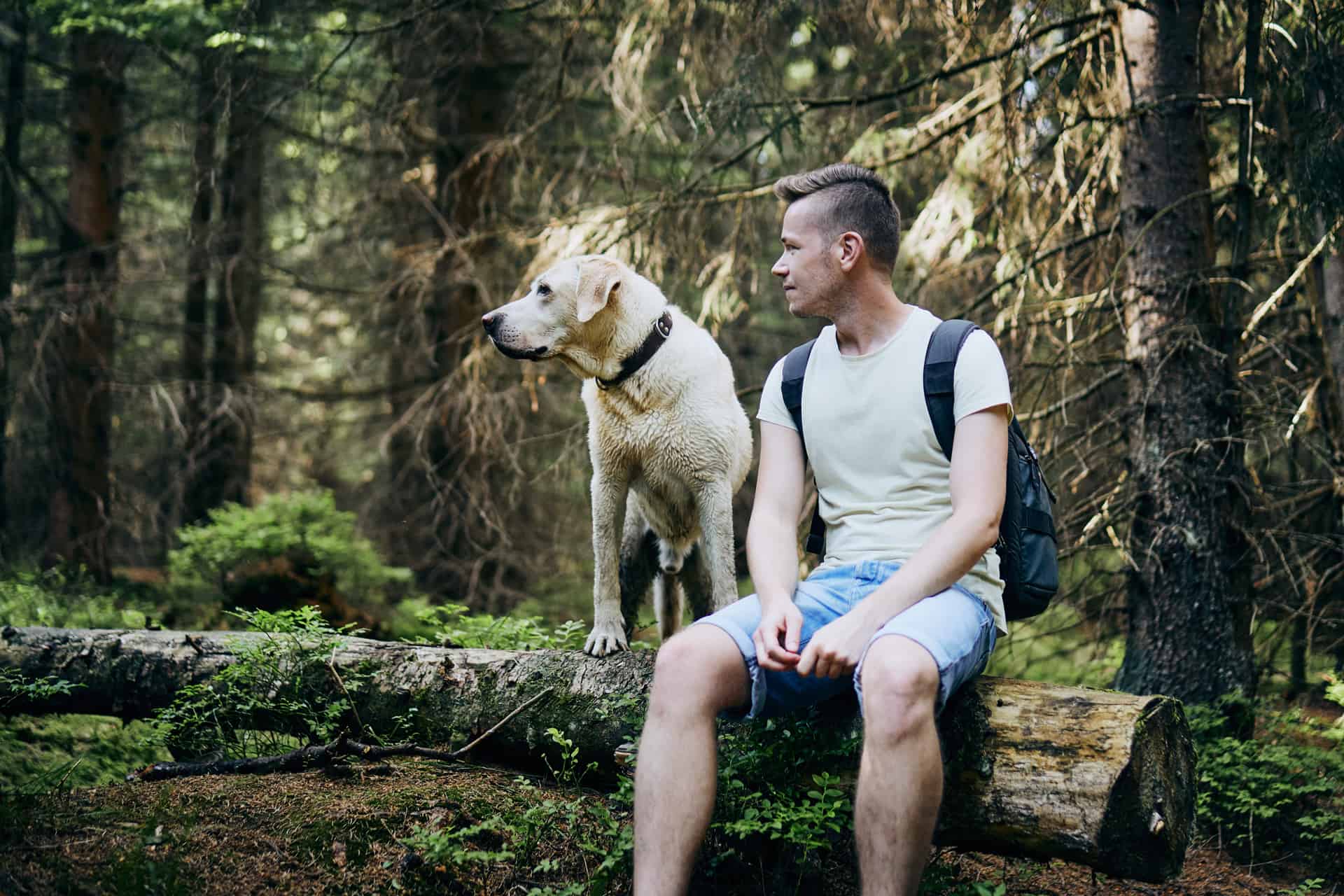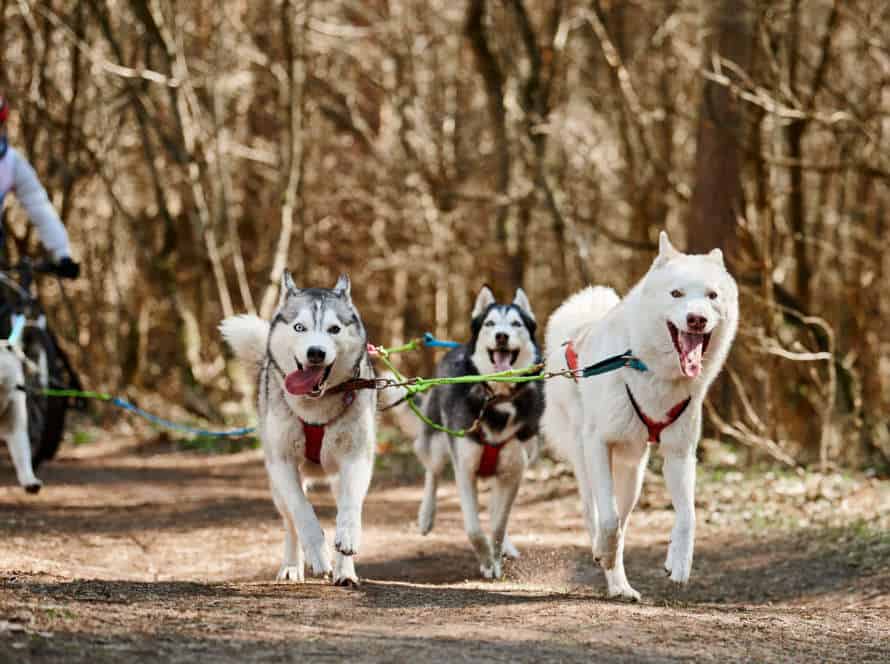Building Your Dog’s Stamina for Long Hikes
Increase your pup’s stamina for lengthy hikes with gradual exercise and endurance training! Here are some pointers to help:
- Start slow – begin with short walks and gradually up the distance and time you spend out.
- Vary terrains – hike on different surfaces to strengthen muscles and build endurance.
- Stay consistent – keep up a consistent activity routine to help your pup build strength and stamina.
- Check health – make sure your dog is fit enough to handle long hikes by visiting the vet regularly.
- Hydrate and snack – bring enough water and snacks to keep them energized and hydrated throughout.
- Pro tip – remember endurance in dogs is a process, so it’s vital to train regularly to keep them healthy and ready for lengthy hikes.
Outline-
Make sure your pup is ready for extended outdoor adventures by building their stamina! Here’s a guide:
- Begin slow – Start with short walks, then gradually increase the length and time.
- Balanced diet – Ensure they get the calories they need to support their activity level.
- Consistency – Make it a routine. Train regularly.
- Adequate rest – Allow them time to recover & build strength.
- Terrain – Introduce them to different surfaces, like hills & rocks.
- Positive reinforcement – Give treats, toys, and verbal praises to motivate them.
By following this, and monitoring your pup, you can build the stamina they need for long hikes!
Understanding Your Dog’s Health and Abilities
Before a hike with your pup, comprehend their health and ability. Each pooch is unique and calls for different levels of physical and mental readiness. To make sure they’re safe and having a blast, build their stamina and check their physical condition first. This is key to a successful long hike!
Consult with a vet before increasing exercise
Consult with a veterinarian first! They can check your pup’s health and recommend the best exercise for its needs. Here are tips for long hikes:
- Start small and build up.
- Take breaks, bring water and maybe add some weight in the backpack.
- Monitor signs of exhaustion – panting, slowing down, or lagging behind.
- Pro tip: Listen to your dog and adjust the routine if needed.
- Avoid overexertion and injury!
Consider age, breed, and personality type
For long hikes, you must consider your dog’s age, breed, and personality type to avoid harm.
- Age: Puppies and seniors have lower stamina, so talk to your vet about if your pup is fit for hikes.
- Breed: Breeds with short legs, like Dachshunds, may not be able to handle long hikes. But, Golden Retrievers are known for their energy.
- Personality type: Anxious or reactive dogs may not be suitable for long hikes. Make sure you create a comfortable environment for them.
- Lastly, train your pup gradually, build their endurance slowly, and bring water/treats to keep them hydrated/replenished.
Look for signs of fatigue or strain
Before a long hike with your pet, it’s vital to build their strength. Look out for signs of exhaustion or stress. Here are some tips to increase your pup’s stamina:
- Begin with brief strolls and, over time, up the distance.
- Mix up their exercise routine with activities like running or fetch.
- Feed them a balanced diet for optimum physical health.
- Keep them hydrated during exercise, especially in hot weather.
Watch for these signs of fatigue/strain in your dog:
- Heavy panting/breathing issues
- Excessive thirst
- Limping/stiffness
- Refusing to move/lie down
- Excess drooling
If you spot any of these signs, take a break, give them water and let them rest.
Training Your Dog for Endurance
Taking a hike with your pup can be a fun and rewarding experience. But, it is important to ensure your pup is prepped for the challenge. Therefore, you should train your dog for endurance! This will help them build stamina and muscle strength. Here are the best methods to do this:
- Start Slow: Begin with a short walk and increase the distance gradually over time.
- Choose the Right Terrain: Start training on flat surfaces, then slowly increase the incline and difficulty of the terrain.
- Stay Hydrated: Bring water for both you and your pup and take frequent water breaks.
- Provide Rest: Allow your pup to rest and recover frequently during the hike.
Start with short, frequent walks/hikes
To build your pup’s stamina for long hikes, a gradual and steady approach is key. Start with regular, short walks or hikes at a pace that’s comfortable for both of you. Increase the distance and duration by 10-20% each week.
Choose a route with different terrains, so your pup can practice their muscles and coordination. Pack water and snacks to keep them hydrated and energized. Keep an eye out for signs of fatigue like lagging or panting, and adjust to their needs.
Incorporate uphill hikes or inclines to strengthen endurance. Try a backpack or weighted vest for extra challenge and muscle-building. Pro tip: Reward your pup with treats or a toy after a successful hike to encourage good behavior and make it more fun.
Gradually increase distance and elevation
To help train your pooch for a challenging hike, do these four things:
- Begin at a snail’s pace. Start with small walks, extend the distance over a few weeks.
- Climb hills. As your pup builds up strength, add in elevation with hills or inclines.
- Be consistent. Repetition is key when training for endurance. Train often and establish a routine.
- Monitor their health. Keep an eye on their behavior and health. Watch for signs of injury, exhaustion, or dehydration. Heavy panting, limping, and unwillingness to continue are all warning signs.
By gradually increasing distance and elevation, and monitoring your pup’s health, you can get them ready to go the distance on long hikes.
Pro Tip: Before any long hikes, speak to a vet to make sure your pooch is healthy and ready for the challenge.
Incorporate interval training to improve endurance
Interval training can help your pup’s endurance. Short high-intensity bursts, followed by longer low-intensity exercise. It increases their cardiovascular capacity and boosts their endurance.
Here are a few tips to give it a go:
- Sprint and rest – 10-15 second sprints, 30-60 second rests.
- Hill runs – sprint up steep inclines and walk back down.
- Fetch – play fetch and after each return, have them sprint back.
- Start slow and check with the vet first.
Enjoy exercising with your furry friend!
Nutrition and Hydration for Your Dog
If you’re planning on longer hikes with your pup, they need nourishment and hydration. Proper nutrition and hydration can help them become more fit and ready for longer treks. Let’s discuss what your pooch should eat and drink to stay healthy and strong for outdoor activities.
Provide adequate hydration during exercise
Hydrating your pup during exercise is important to keep them safe and healthy, especially on long hikes. Without hydration, they can get sick from dehydration and overexertion. Here are some tips to help:
- Bring enough water for both you and your pup. Take water breaks regularly.
- Use a hydration pack for dogs. It’ll help them drink while walking or hiking.
- Know their hydration needs. These vary based on size, breed, and activity level.
Giving proper hydration during exercise can help prevent heat exhaustion and dehydration, plus keep them healthy and happy.
Bring high-energy snacks for extended hikes
High-energy snacks are key for long hikes with your pup. Freeze-dried liver treats, jerky, and peanut butter are all great options. They’re high in protein and easy to take along. Don’t forget water and a bowl for your dog to stay hydrated. Before introducing new foods, always check with your vet.
Monitor your dog’s weight and adjust diet as necessary
Tracking your pup’s weight and adjusting its diet is key for their health and strength for long hikes. Here are some tips:
- Check your dog’s weight and BCS (Body Condition Score) by feeling the ribs and waist.
- Talk to your vet to know ideal weight and daily calorie intake.
- Pick a high-quality food that fits the age, activity and nutrition needs.
- Keep adjusting diet based on weight and activity.
- Avoid overfeeding, to avoid weight gain and other issues.
- Give clean water regularly to keep pup hydrated.
- Exercising regularly will help maintain weight and energy, which makes long hikes more fun for your furry friend!
Preparing for an Extended Hike with Your Dog
Eager for an extended hike with your pup? Fantastic! It needs prepping, though – for both of you. Your dog must build up its strength for the extra hike time. Here’s how to prep your pup for a longer hike:
- Visit the Vet: Check with the vet to ensure that your pup is healthy enough for an extended hike.
- Build Endurance: Start with short walks and gradually increase distance and time.
- Pack enough water: It is important to stay hydrated during the hike.
- Carry Snacks: Hiking takes a lot of energy. Don’t forget to bring high-energy snacks for both you and your pup.
- Leash & Collar: Keep your dog leashed while hiking and make sure the collar fits properly.
- Protect the Paws: Check your pup’s paw pads for any injuries or irritations. Consider using booties, especially during long hikes.
Plan your route and consider rest stops
When you plan a long hike with your pup, route-planning and rest stops are key. Before setting off, consider things like your pup’s breed, age, health, the weather, the length and difficulty of the trail, and water availability. Choose a trail that suits your dog. Plan rest stops along the way. Bring plenty of water and snacks. And don’t forget a first-aid kit in case of any mishaps!
Pack necessary supplies for your dog (water, food, first aid)
When planning a long hike with your pup, it’s essential to bring supplies for their safety and comfort. Here are the must-haves:
- Water: Take enough water to keep your dog hydrated. Dehydration is serious and must be avoided.
- Food: Bring high-energy food to maintain energy levels. Lightweight, easy-to-carry, and high-calorie food is best.
- First-Aid Kit: Includes bandages, antiseptic, and tweezers. Essential for quick care in case of injury or sickness.
- Other Supplies: Leash, collar, waste bags, and a towel or waterproof blanket.
Pro tip: Talk to your vet for personalized advice on calories, water, and other supplies for your pup before any long hike.
Understand proper trail etiquette and regulations
Before hiking with your pup, it is essential to know the right trail etiquette and regulations. Here are some tips:
- Keep your pooch on a leash if the rules say so.
- Pick up after your doggy with waste bags and dispose of it properly.
- Stay on the marked trail to protect the environment.
- Move over to the side of the trail and let other hikers and horses pass.
- Bring water and snacks for you and your pup and obey fire and camping regulations.
- Pro tip- Pack a first aid kit with disinfectant, bandages and ointment for you and your furry pal.
Frequently Asked Questions
Q: Can all types of dogs go on long hikes?
A: No, not all types of dogs can go on long hikes. Dogs that are older, have health problems, or are of certain breeds might not be able to handle the physical demands of a long hike.
Q: How do I prepare my dog for a long hike?
A: Gradual exercise is key. Start by taking your dog on shorter walks and gradually increase the distance and difficulty of the walks. Also make sure your dog is adequately hydrated, well-fed, and has proper gear such as a comfortable harness.
Q: Can dogs get tired during a hike?
A: Yes, dogs can get tired during a hike just like humans. It’s important to monitor your dog’s behavior and energy levels throughout the hike and take breaks as needed.
Q: What are some signs of fatigue in dogs during hikes?
A: Some signs of fatigue in dogs during hikes include excessive panting, slowing down, lagging behind, and lying down frequently.
Q: Can dogs hike in any weather?
A: No, dogs should not hike in extreme weather conditions such as extreme heat or cold. It’s important to plan hikes around moderate weather conditions and always bring extra water for hydration.
Q: What do I do if my dog becomes injured during a hike?
A: If your dog becomes injured during a hike, stop the hike and tend to your dog’s injuries. Seek medical attention if necessary, and always carry a first-aid kit with you on hikes.







